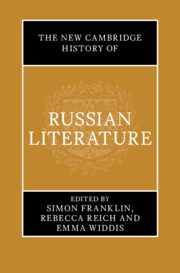Book contents
- The New Cambridge History of Russian Literature
- The New Cambridge History of Russian Literature
- Copyright page
- Contents
- Figures
- Contributors
- Acknowledgements
- On Transliteration, Names, and Dates
- Introduction
- History 1 Movements
- History 2 Mechanisms
- 2.1 The Monastery
- 2.2 The Court
- 2.3 The Salon and the Circle
- 2.4 The Thick Journal
- 2.5 The Publisher
- 2.6 Queerness
- 2.7 The Censor
- 2.8 The Voice
- 2.9 The Self-Publisher
- 2.10 The Market
- 2.11 The Internet
- 2.12 Empire
- Boxes 3 Places
- Boxes 4 Narrative Voices
- History 3 Forms
- History 4 Heroes
- Index
- References
2.1 - The Monastery
from History 2 - Mechanisms
Published online by Cambridge University Press: 31 December 2024
- The New Cambridge History of Russian Literature
- The New Cambridge History of Russian Literature
- Copyright page
- Contents
- Figures
- Contributors
- Acknowledgements
- On Transliteration, Names, and Dates
- Introduction
- History 1 Movements
- History 2 Mechanisms
- 2.1 The Monastery
- 2.2 The Court
- 2.3 The Salon and the Circle
- 2.4 The Thick Journal
- 2.5 The Publisher
- 2.6 Queerness
- 2.7 The Censor
- 2.8 The Voice
- 2.9 The Self-Publisher
- 2.10 The Market
- 2.11 The Internet
- 2.12 Empire
- Boxes 3 Places
- Boxes 4 Narrative Voices
- History 3 Forms
- History 4 Heroes
- Index
- References
Summary
During the age of devotion, monasteries were the dominant institutions for the production, preservation, and consumption of books. This chapter uses a spatial device to map the character and range of monastic writing and reading. Monastic book consumption is described in terms of three zones. The first zone is the church, with the books needed for the performance of the liturgy and to support services every day of the year. The second zone can be represented by the refectory or other communal space, where the monastic Rule advised that, rather than engage in idle chatter, the brethren should listen to the reading of instructive and edifying texts. The third zone is the individual cell, the zone of texts for private reading. The chapter’s main temporal focus is on the period from the late fourteenth century to the end of the fifteenth century, the main age of monastic expansion.
- Type
- Chapter
- Information
- The New Cambridge History of Russian Literature , pp. 227 - 240Publisher: Cambridge University PressPrint publication year: 2024

